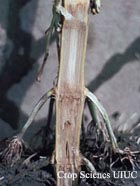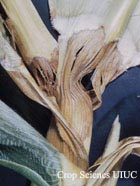Bacterial Stalk rot


Symptoms
- Symptoms are similar to those of Pythium stalk rot
- One or more of lowest internodes will turn tan to brown and become water soaked, soft, or slimy and there may be a foul odor
- Upper leaves wilt and a soft rot can occur at the base of the whorl, and this may spread rapidly down the plant and cause lodging
Pathogen Involved
- Erwinia chrysanthemi pv. zeae (bacterium)
- Wide host range, including monocots as well as dicots
- Infection sites are stomata, hydathodes, or the wounds of leaves or stalks
- Overwinters in stalk residue on the soil surface line
- May be transmitted by larvae of the maize borer
Time of Occurrence
- Occurs in midseason after pollination of corn
- Top rot can occur in plants that are sprinkler irrigated during periods of rapid growth
Conditions Favoring Disease
- High Temperatures (88-95°F)
- High amounts of rainfall and flooding
- Overhead irrigation
- Insect injury
Disease Management
- Incorporate soil debris with fall plowing
- Avoid flooding and excessive overhead irrigation